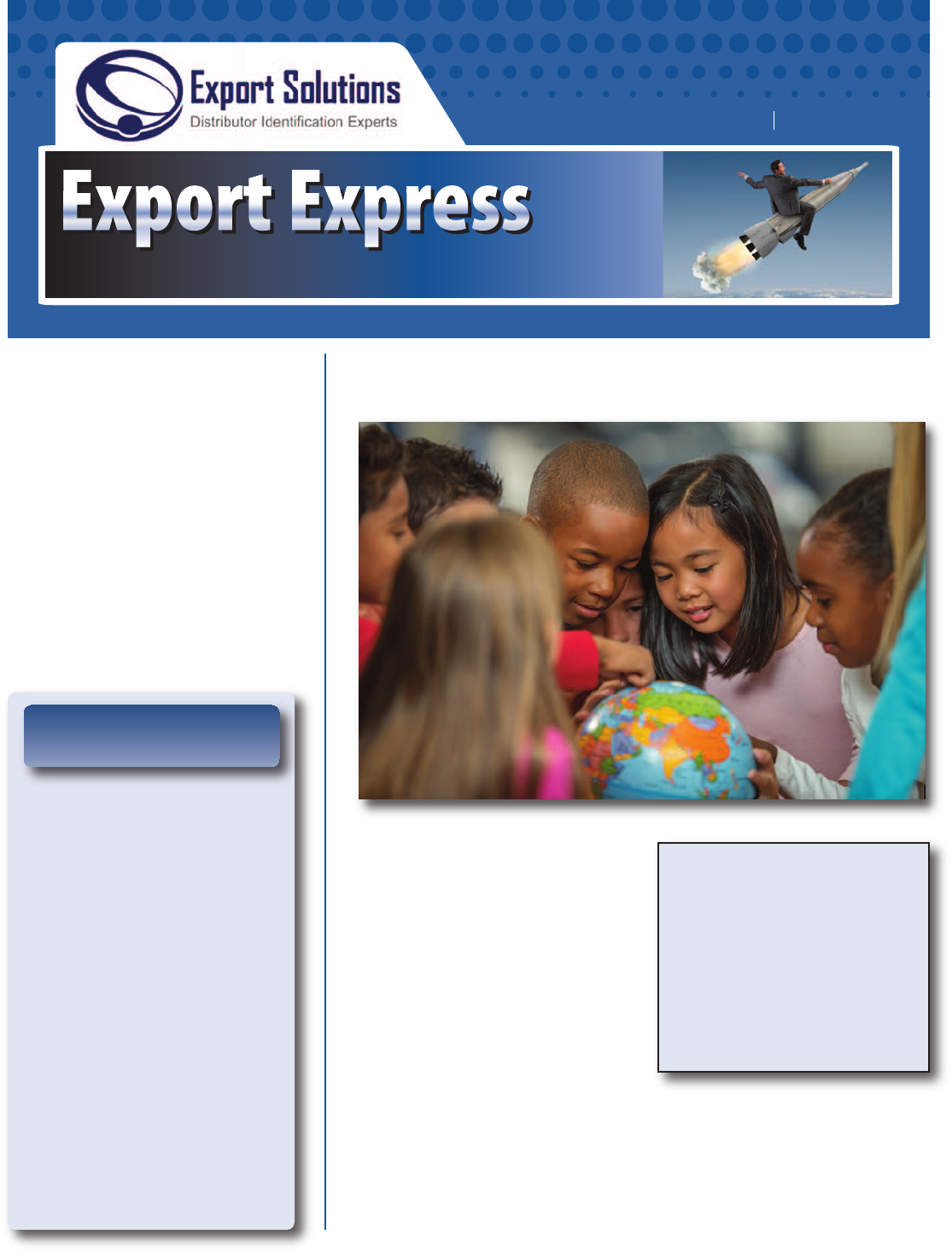
The UN projects that the world
population will reach eight billion
in November. This milestone reflects
one billion new citizens gained since
2011. Sixty percent of the world’s
population resides in Asia, almost
five times the combined total of
Europe, USA, Canada, and Australia.
The west still maintains a sizable
advantage with purchasing power.
However, an enormous opportunity
exists targeting the top 20% of Asia’s
population, a market exceeding one
billion people. “Mouths plus money
equals opportunity.”
Lessons Learned
Why does it surprise us that Chinese
people prefer Chinese food and Indians
opt for Indian food? How popular is
authentic Chinese food in Italy? Italian
food has had some success pioneering
across Asia. However, the clear
conclusion is that western food has
struggled to attain popular acceptance
in the high-growth, emerging market
countries. Our brands remain niche,
Insights to Accelerate International Expansion
Fall 2022
Volume 14 Issue 4
Our Mission: Help Manufacturers “Spend time Selling to Distributors versus Searching for Distributors”
In This Issue
Looking for New
Distributors?
How about 9,300? Export Solutions’
distributor database has helped 3,000
brand owners in 14 years speed up the
process of finding qualified distributors.
Our database covers an average of 85
distributors per country of supermarket
type products for 96 countries. Search by
country, category, brand name, or country
of origin. Experts for Europe, Middle
East, Latin America, and Asia with
complete regional coverage. “Spend
time
selling
to distributors versus
searching
for distributors.”
Now Serving: 8 Billion
Page 2
What Is the Size of the Prize?
Page 3
Euro-USD Exchange Rate:
Money Matters
Page 4
Food Diversity Quotient:
Export Potential Indicator
Page 5
What Distributors Like
Page 8
Exporter Classification
Page 9
Distributor Classification
Page 10
FAQ’s
– Distributor Database
continued on page 7
2023 Hot Markets
1. USA
(International Brands)
2. Saudi Arabia
3. VIP’s: VN, ID, PI
4. Poland
5. Mexico
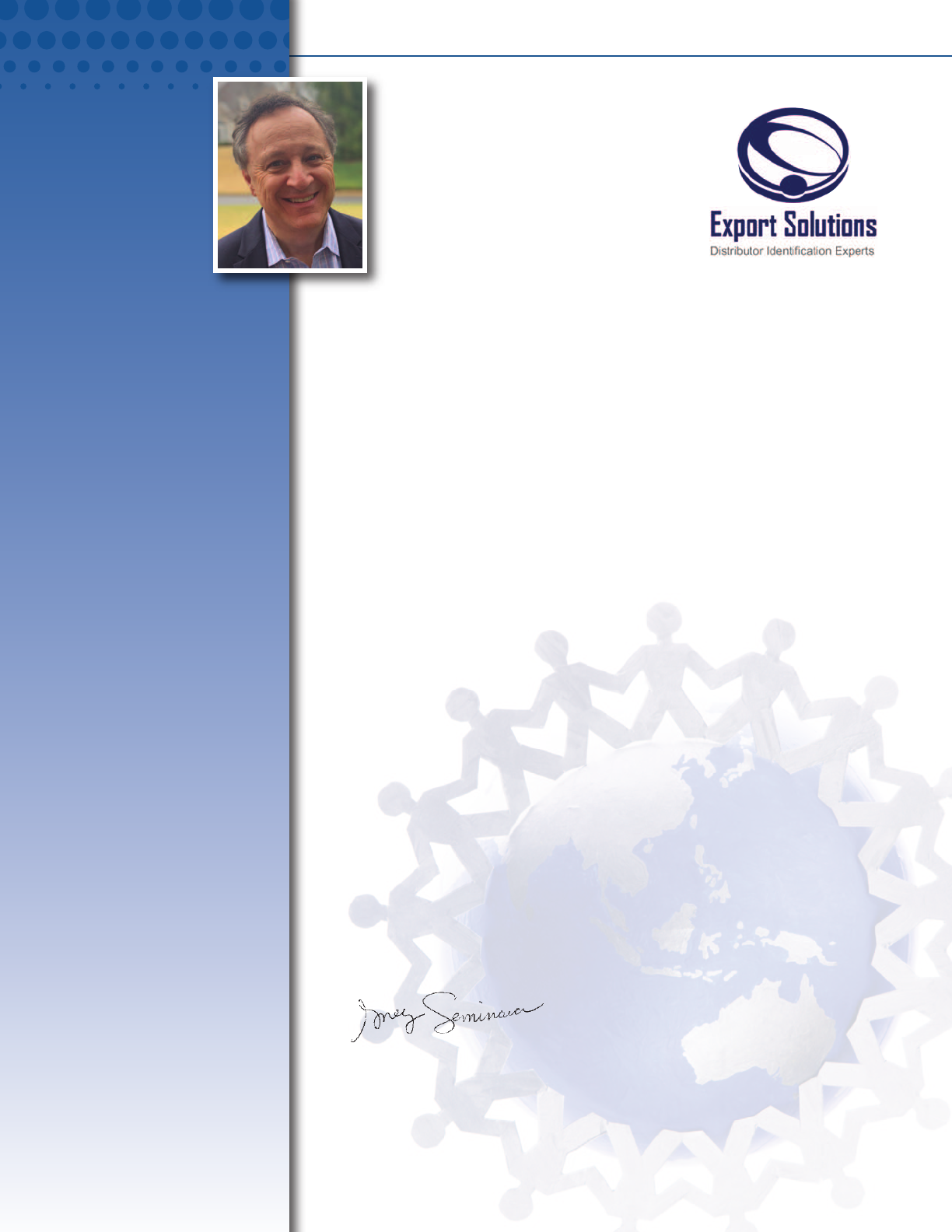
2
Every job seeker is trained to quickly
gauge the salary range before dedicating
energy to the interview process.
Then why do companies searching for
international distributors and new retail
placements ignore the question on every
buyer’s mind? What is the size of the prize? As export managers tout product
benefits and overseas success, the distributor “customer” is quickly calculating how
much revenue and profit your product line can generate in his country. Distributors
are motivated by a big prize, just like you would be tempted by a new job offer with
a lucrative compensation package.
1. All distributors are scouting for new business opportunities.
I help multinational companies like Barilla, Tabasco, Lindt, and General Mills on
distributor projects. Leading distributors receive at least ten new representation
opportunities per month. They make a quick initial assessment and respond with
urgency for an attractive prize from a strategic brand owner.
2. Is your size of the prize estimate real?
Distributors appreciate companies with existing business in their country. This provides
more accurate guidance on market potential. Pioneering from zero sales is tough!
Distributors respect fact-based sales forecasts based upon category size, market share,
pricing, and unique product benefits.
3. Sales performance is directly related to brand support investment levels.
Distributors may be more impressed by a company with a strong marketing support
campaign commitment versus another brand with a breakthrough positioning, but
limited investment in brand building. A brand’s marketing budget commitment offers
critical clues on the size of the prize.
4. Is it worth the effort?
Distributors are magicians at allocating limited team resources. Your product range may
be tempting, but how difficult will the task be to launch your brand, gain traction and
repeat sales? Most distributors select a maximum of two or three new companies each
year from the mountain of inquiries received.
5. Apply the same discipline to distributor inquiries.
Export managers may be overwhelmed by inquiries from small traders or distributors
from remote countries. Standardize your process to avoid speaking with “time wasters.”
Our motto “Select your distributors, do not let your distributors select you!”
Distributors maintain sales growth and profit objectives just like your company. Most
distributors are independent, family-owned companies. Logically, they elect to invest
their own money and team resources when a lucrative prize appears. Brands that remain
focused on distributor benefits will be successful at attracting a strong network of best-
in-class distributors.
Good Luck!
Strategic Services
Contact Us for
Export Solutions
1. Identify Best in Class
Distributors: 96 Countries
2. Best Practices
Export Strategy
3. Distributor Management
Workshops
4. Export 101:
Let’s Get Started
5. New Market
Prioritization
and Launch Plan
6. Personal Distributor
Introductions:
96 Countries
7. Walmart International
8. Distributor Contracts,
Margins, and Fees
9. Meeting Speaker
10. International
Strategy Expert
Strategic Services
Contact Us for
Export Solutions
1. Identify Best in Class
Distributors: 96 Countries
2. Best Practices
Export Strategy
3. Distributor Management
Workshops
4. Export 101:
Let’s Get Started
5. New Market
Prioritization
and Launch Plan
6. Personal Distributor
Introductions:
96 Countries
7. Walmart International
8. Distributor Contracts,
Margins, and Fees
9. Meeting Speaker
10. International
Strategy Expert
www.exportsolutions.com
Greg Seminara
“Spend Time Selling to Distributors versus Searching for Distributors”
What is the Size
of the Prize?
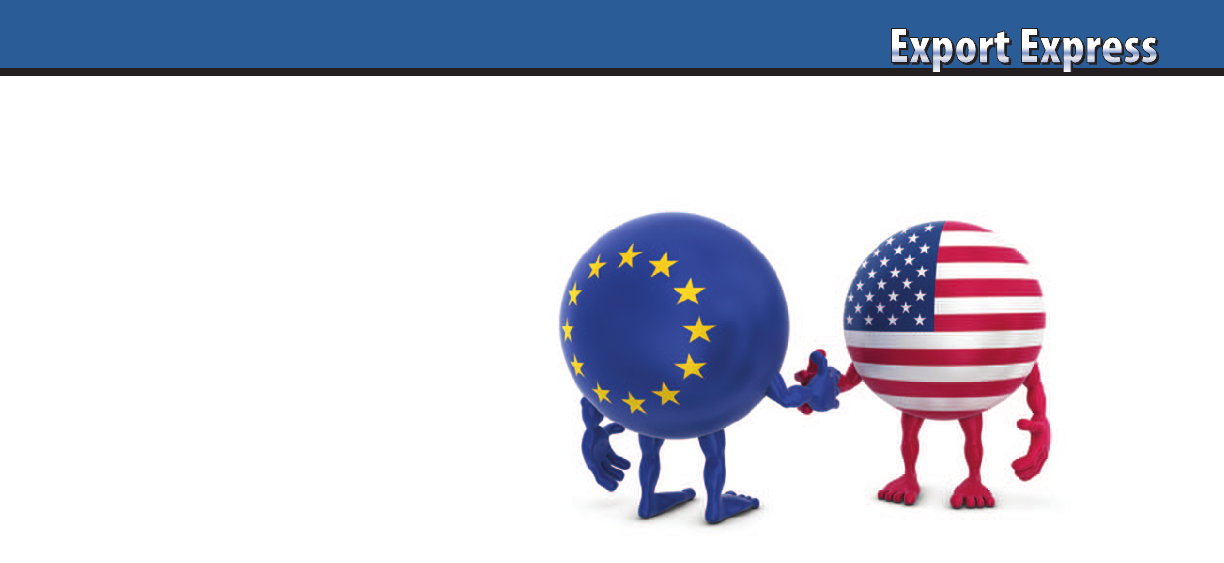
The euro and USD trade at parity for
the first time since July 2002. The recent
euro devaluation is a direct result of
instability created by the Russian invasion
of the Ukraine. The euro has declined
16% versus last year and historic levels
ranging from 1.13-1.20. Other benchmark
currencies such as the UK pound and
Japanese yen trade at multi-year lows.
This signals some pain for USA
multinationals such as P&G, Mondelez,
and Kraft Heinz, with sizable European
businesses. On the other hand, European
exporters may discover a unique window
of opportunity to develop their USA
business due to a more competitive
pricing framework.
USA: Retail Business Remains Strong
There is a permanent shift to food
consumed at home in the USA. Most food
brands are tracking 5-10% ahead of last
year through a combination of steady
volume and price increases. Home-based
workers now purchase food from
supermarkets for breakfast and lunch.
Dinners feature more inspired meals, as
people do not suffer through the evening
commute. Restaurant prices have
skyrocketed, especially in the fine dining
segment, making eating out a special
occasion event versus a regular habit. As
a result, USA consumers are searching for
new options and open to spending a little
more for innovative brands from Europe,
Asia, and the Americas.
415 USA Retailers
Export Solutions’ retailer database tracks
415 USA customers, segmented by state
and by channel. There are plenty of
small- to mid-size chains willing to
try an international brand to offer a
differentiated assortment versus national
players such as Walmart and Kroger.
International brands should offer a
compelling story, category innovation,
and a commitment to brand support.
A difference versus Europe is that the
average USA store sizes exceeds 40,000
square feet (4,000 sq. meters) with plenty
of space. Hard discount is not a factor,
with Aldi, Lidl and others accounting
for 2% market share. Private label market
share is only 18.8% according to Nielsen.
A proven strategy is to build a presence
at high-profile premium retailers before
gradually expanding to mass operators.
Three-Tier Model
Most overseas brands partner with
one of the 614 "importer"distributors in
our USA distributor database. In the USA
“distributors” usually refers to wholesale
distributors such as UNFI or Kehe.
International brands must consider
three margins in their value chain:
importer distributor, wholesale
distributor and retailer. However,
with a lower cost basis due to currency
and elimination of Trump-era tariffs,
many European producers are more
competitive today than at any time
in their recent history.
Saudi Arabia, UAE, Panama, HK, & Ecuador
Many countries peg their currency to the
USA dollar. This includes the Gulf nations
and the Caribbean islands. Panama is an
attractive growth market, a hub for Latin
America. Ecuador features a population
of 18 million and the USA dollar is legal
tender. Hong Kong features high
acceptance of international brands. All
of these countries are worthy of renewed
consideration due to the current euro
exchange rate.
USA Brands: More Marketing
Made in the USA brands will experience
higher price points in Europe. However,
a strong dollar also translates to more
marketing muscle for overseas investments
due to the elevated purchasing power of
the dollar. Next year may be the time to
stretch your investments in social media,
sampling, and promotion to build long-
term brand equity.
Revisit your Price Calculation
Successful distributors are brand builders
versus currency traders. Value-chain
calculations should be examined to
ensure that all partners maintain a fair
mix of profit and investment, without
currency fluctuation shifts falling to
the bottom line. Online price checks of
retailer web shops allows you to instantly
check the current assortment and pricing
of most leading USA retailers including
Walmart, Kroger, and Costco.
Retail Safari
One option to accelerate your North
America growth strategy is to participate
in a Retail Safari program from Export
Solutions. This “hands on”, commercial
approach allows companies interested
in USA development to benefit from
an intensive look at the USA and your
category. Participants in this one-week
program visit three or four benchmark
cities like Atlanta, Metro New York,
Los Angeles, and Toronto. Atlanta is
critical as the commercial capital of the
populated south (38% of USA) as well
as an opportunity to check all national
retailers in one suburb to see the real
USA market: Walmart, Costco, Kroger,
Publix, Whole Foods, Trader Joe’s,
Target, Sam’s Club, Fresh Market, etc.
Metro NY (or Boston) allows you to
observe more regional chains, with lower
cost-of-entry requirements. The Retail
Safari includes daily briefings on core
topics such as USA broker models, trade
promotion strategies, and value chain
calculation. Contact Greg Seminara for
more information.
3
Euro-USD Exchange Rate: Money Matters
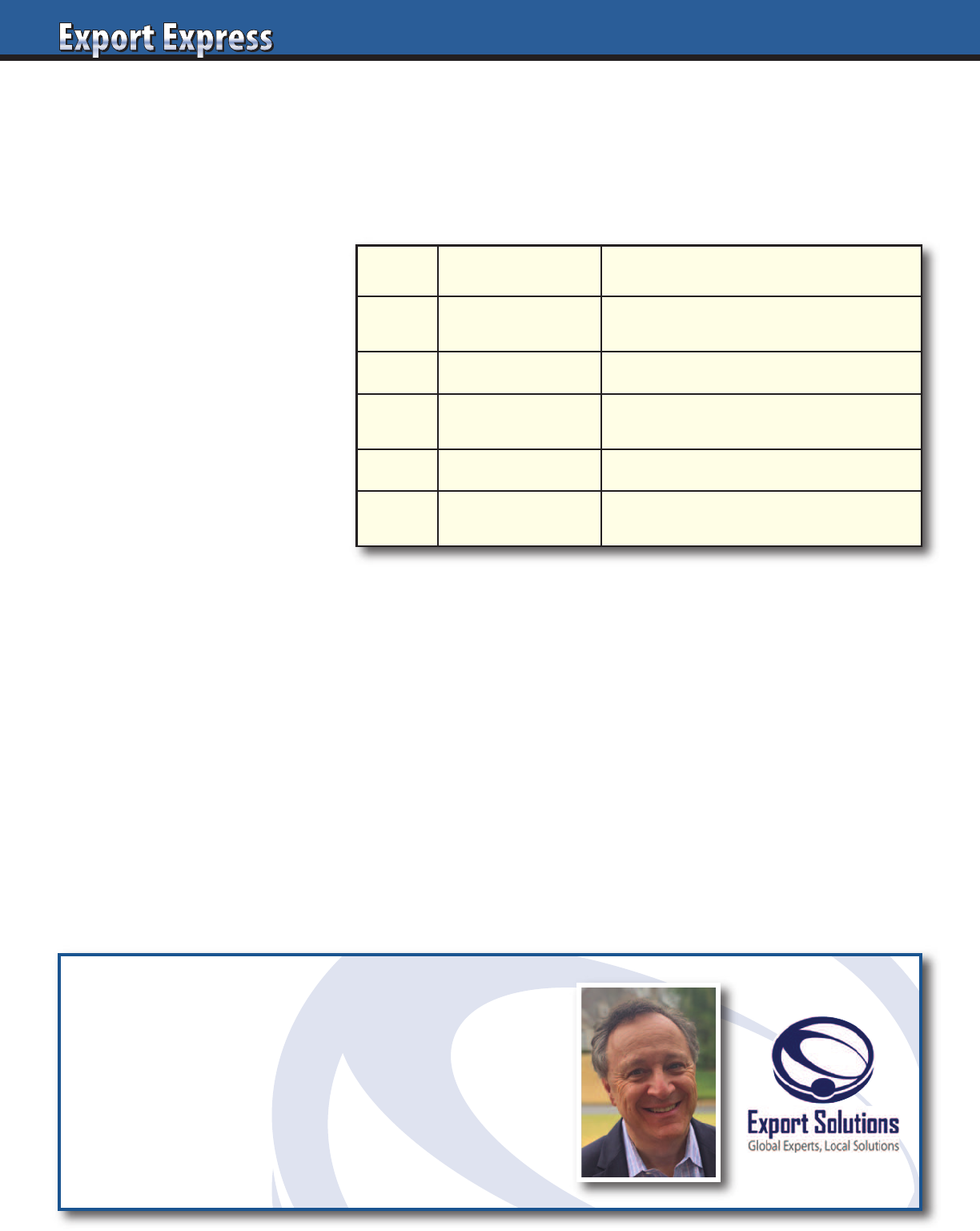
Food Diversity Quotient:
Export Potential Indicator
4
Why are some countries more receptive
to international foods than others? My
informal analysis reveals that certain
countries have adopted world foods as
a regular part of their diet. For example,
a typical USA family consumes Italian
food, Mexican food, and Asian food
multiple times per month. Other
countries maintain deep appreciation
of their own traditional recipes, with few
citizens venturing to explore dishes from
foreign lands. This is a factor why China
and India are difficult to enter and why
the UK, UAE, and Singapore are open.
Examining the Food Diversity Quotient
of a country may serve as an indicator of
receptiveness to your product portfolio.
5 Stages
Every country maintains a mix of
consumers who eat primarily local foods
to world travelers regularly enjoying
a diverse mix of international menu
options. Credit the Italians and Chinese
for years of hard work pioneering their
delicious cuisines to the mainstream
in many countries. Now Mexican and
Japanese are gaining traction. The leading
ethnic food distributor in France stated
“during Covid, people could not travel
overseas on airplanes, so they began
traveling in their kitchens instead.”
Mass Versus Gourmet
An important data point is the percentage
of the population regularly consuming
food at different stages. Is it just a few
high-income gourmets, travelers, and
homesick expatriates? Or do most people
in a country periodically enjoy pasta,
tacos, and sushi? Understanding the
country-level Food Diversity Quotient
requires an assessment of whether the
consumption of international food is a
regular habit practiced by the masses,
or niche.
Retail/Foodservice Clues
One way to determine acceptance is
to track the size of international food
sections in supermarkets. Is there a big
section of Italian food brands? How many
Mexican or Thai food items are stocked?
Another method is to check the popularity
of restaurants specializing in food from
that country. Are there many Spanish or
Japanese restaurants? Are the restaurants
only in the capital city or countrywide?
Do restaurants exist at multiple price
points appealing to the “hungry student”
and the executive gourmet?
Future
A positive development is the surge
in acceptance of international foods.
There are many factors in country
segmentation and allocation of export
resources. Assessing a country’s Food
Diversity Quotient serves as another
worthy consideration. Export Solutions’
distributor database maintains filters
that allows subscribers to identify
distributors in 96 countries specializing
in food from Italy (1,417), Spain (414),
Germany (653), Latin America (561),
UK (688), Asia (466), and USA (1,205).
For more information, visit
www.exportsolutions.com.
Stage Type Description
1 Local
Traditional Foods
Meat & Potatoes, Noodles
2 Popular Italian, Chinese Food
3 Trendy
Mexican ,Thai, Japanese,
Spanish Tapas
4 Explorers Middle Eastern, Indian, Vietnamese
5 World Travelers
Open to All Types of Cuisine:
African, Korean, Greek, Brasilian
Export Solutions Can Help!
• Distributor Search helper in 96 countries
Contact Greg Seminara at
greg@exportsolutions.com
or (001)-404-255-8387
www.exportsolutions.com
Food Diversity Quotient
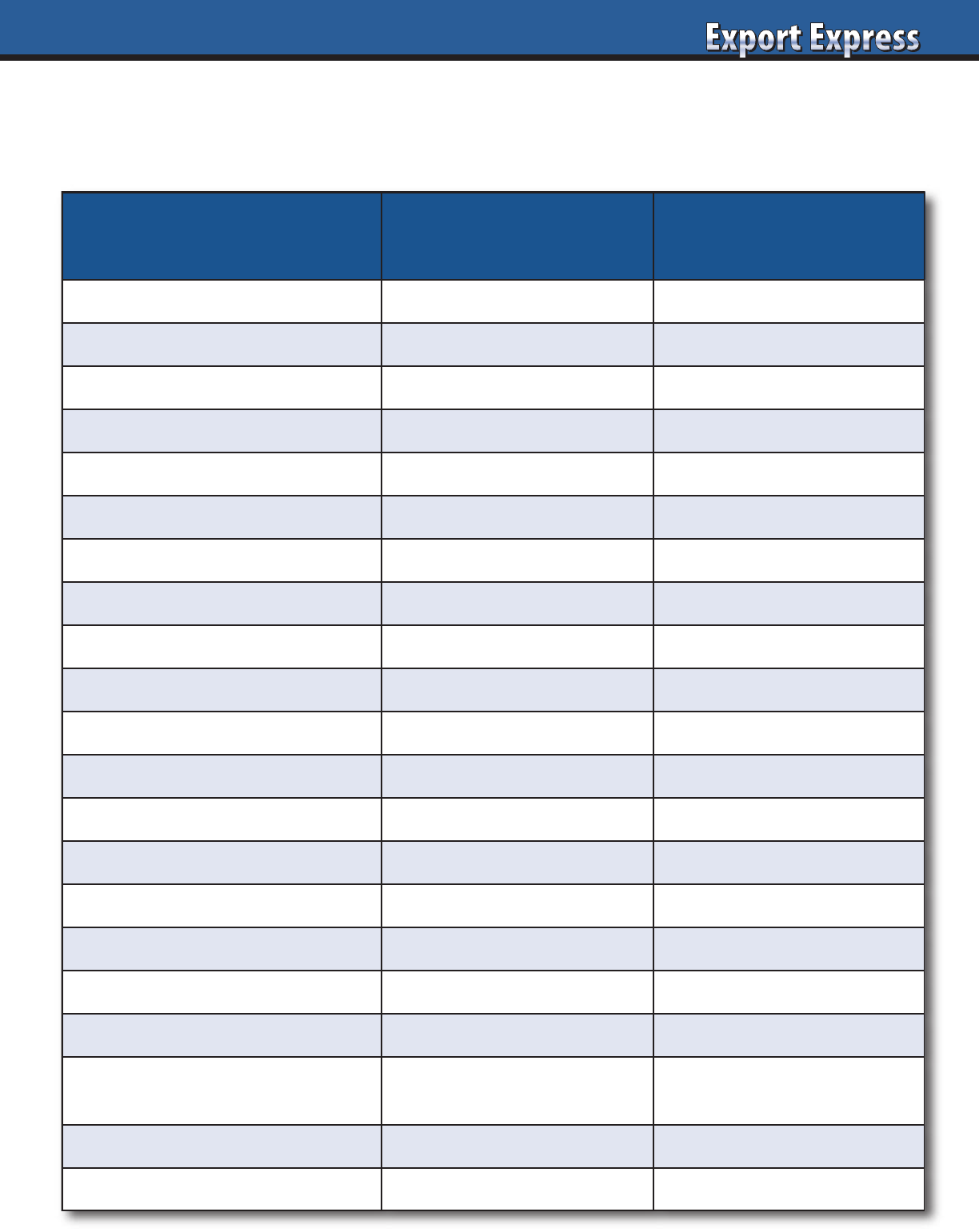
5
What Distributors Like
Distributors deserve respect as they are our customers for an entire country. They serve as "buyers" of our products and pay
our invoices. Distributors allocate more focus to companies that treat them well. Learn what distributors like (and don't like).
Like
Don't Like
Business Scale Category Leaders
Niche
Marketing Spend 15–25% of Sales Dead Net Pricing
New Brands Existing Business Pioneering from Zero
Syndicated Data Nielsen No Data
Consumer Research Local Insights
No Research
Service Level 98% +
Less Than 90%
Innovation Breakthrough
"Me Too"
Export Manager Veteran, 5 Years +
New
Customer Contact With Distributor
Direct
Reporting Basic Dashboard
Non-Essential Reports
Marketing Budget Local Events No Budget
Billback Repayment
30 Days or Less 60-90 Days +
Brand Facts/Content
Online Portal None
Customer Service
Same-Day Reply Same-Month Reply
Regional Meetings
Popular. Also HQ Invite. Never
Sales Contest
During Peak Season None
Company Visits
Quarterly Weekly or Never
Awards/Thank You
Celebrates Success No Recognition
Senior Management Relationship
Your CEO Maintains
Distributor Relationship
No Relationship
Distributor Margin Respects Healthy Margin
Low Margin
Growth Expectation
5–10%
0% or 20% +
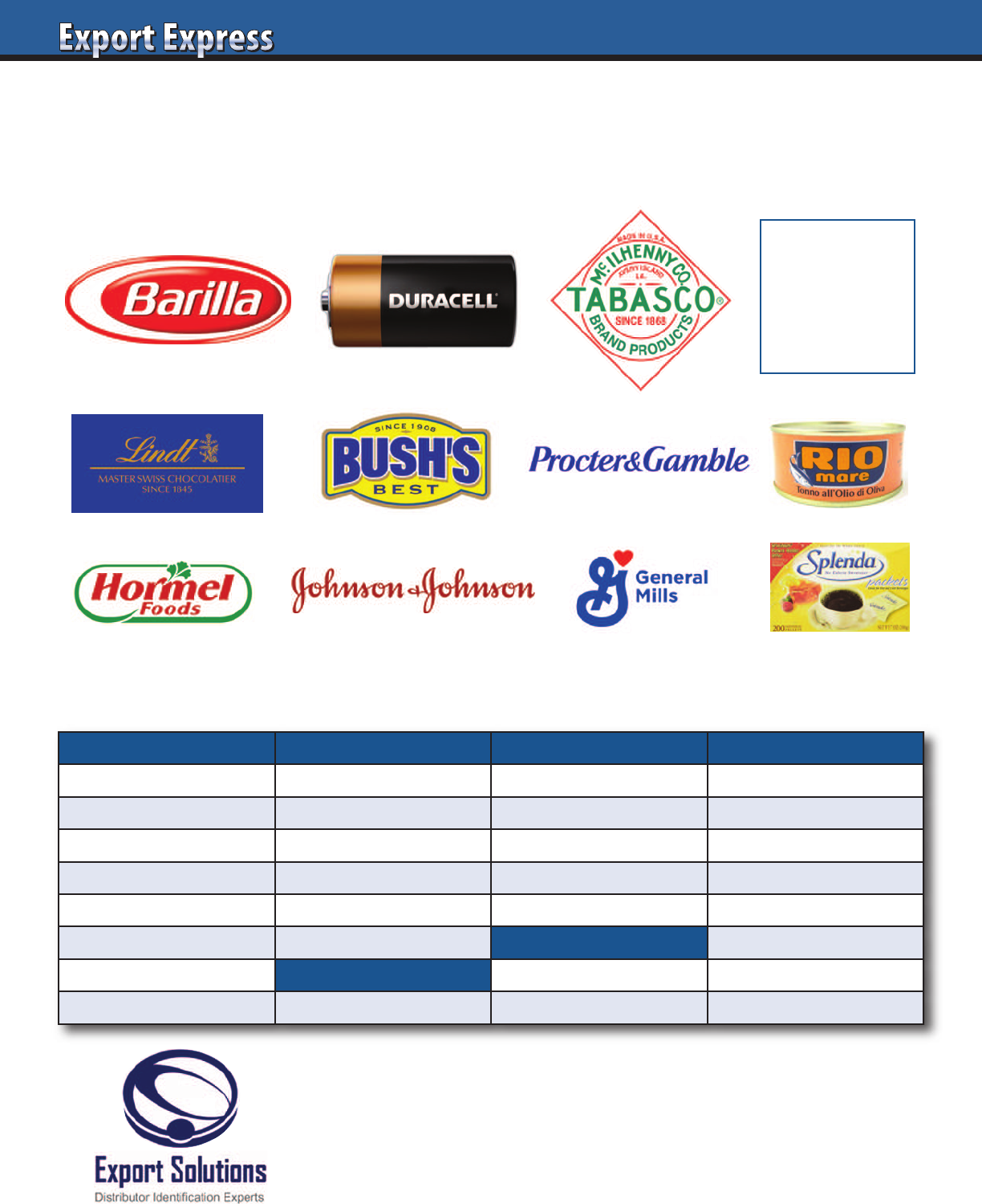
6
Distributor Search Helper for:
Your
Logo
Here
Can We Help You?
Recent Distributor Search Projects
Asia Europe Middle East Latin America
Australia Germany Israel Argentina
China Ireland Kuwait Brazil
Indonesia Netherlands Qatar Colombia
Japan Nordics Saudi Arabia Costa Rica
Malaysia Spain UAE Ecuador
Philippines United Kingdom North America Mexico
Singapore Africa Canada Panama
South Korea South Africa United States Peru
Call the Export Accelerator!
Contact Greg Seminara at greg@exportsolutions.com
to discuss your business development project.
www.exportsolutions.com
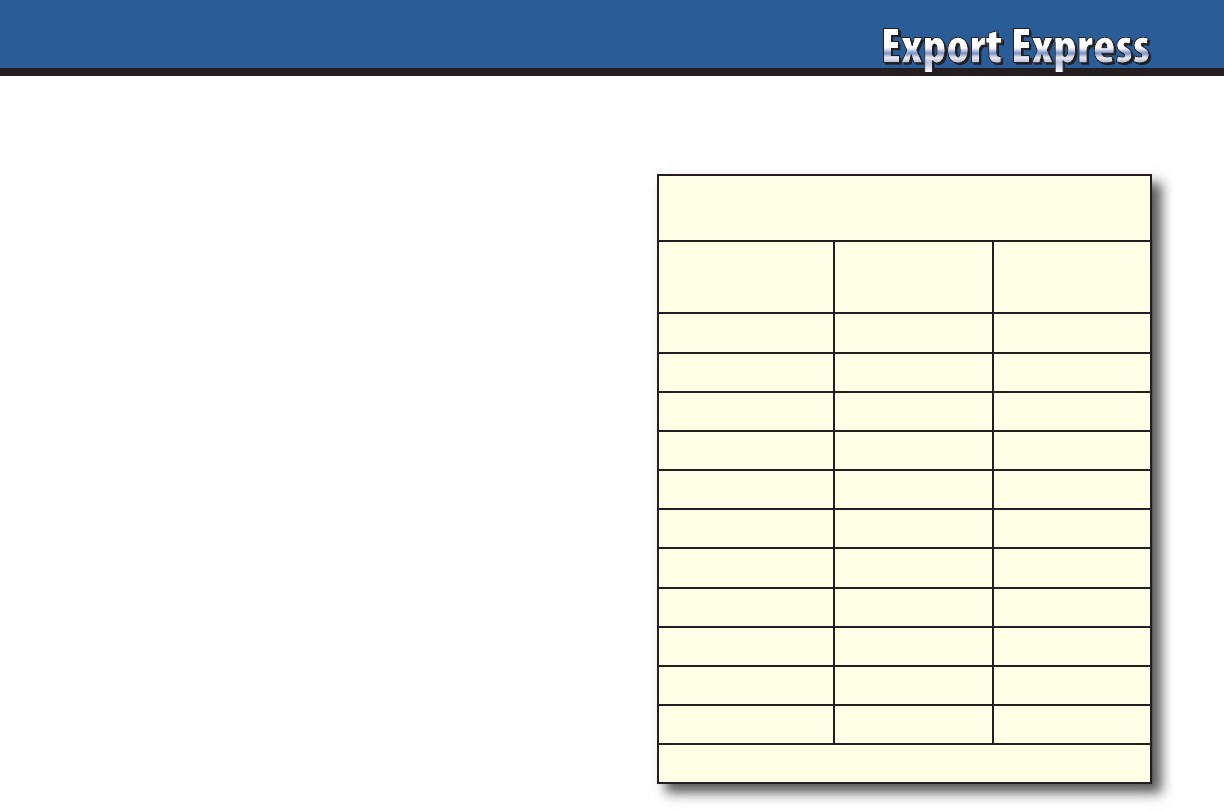
as Asian consumers stick to their
traditional dishes, with European and
USA favorites appreciated by a small
group of upscale culinary explorers.
Confectionery and snack categories
remain exceptions, as everyone enjoys
a sweet treat. Starbucks and Coca Cola
should be recognized for converting
tea drinkers, but these leaders operate
with massive resources, far beyond
most exporters.
Food Diversity Quotient
Examination of a country’s Food
Diversity Quotient (see page 4 article)
supplies important clues on market
prioritization. This may increase the
attractiveness of global cities like Tokyo,
Seoul, and Singapore versus New Delhi
or Jakarta. Another option is to pair your
product with local dishes to create new
recipe ideas. Partner with a local chef
and food technologist for ideas. The
foodservice channel serves as an important
showcase in Asia for Western food.
M & A – Accelerator
Acquisition is an effective strategy to gain
critical mass, particularly in Southeast
Asia. Many consumers appreciate food
from an adjacent Asian country that may
be more similar to their own cuisine.
Large European and USA companies may
“buy local scale” and establish a platform
to produce their core brand locally and
export to nearby countries. Acquisitions
are not “risk free” and frequently require
overseas expatriates to share best
practices and manage the money.
High Class to Mass
Each country features a gourmet
supermarket chain catering to high
income consumers. A success strategy
is focusing trade promotion resources at
these upscale retailers before expanding
availability to mass retailers. For example,
the top ten percent of Indonesia’s
population represents a market of twenty-
eight million people, similar to Benelux.
The middle class totals about fifty million
Indonesians, larger than Spain.
E-commerce
E-commerce appears as a primary source
of revenue for many overseas brands,
particularly in China and South Korea.
This requires a unique go-to market and
investment strategy. Brands targeting
e-commerce may
consider aligning with
a distributor specializing
in this channel. Volume-
oriented companies
should also calculate
brick-and-mortar retail
costs when developing
a total-country pricing
strategy. A streamlined
value-chain model may
succeed for e-commerce
but not function when
competing in the
costly battle for shelf-
space game.
Right Fit Distributors
There are many
powerful distributors
in Asia. A key is to align
your aspirations and
marketing investment
with your distributor
profile. Companies
committed to brand-
building activation
should partner with
massive distributors
with omni-channel capabilities.
However, if you are operating with
a limited budget, consider a smaller,
hungry pioneer willing to dedicate
more resources to launching innovative,
premium products.
Meet the VIP’s
Vietnam, Indonesia, and the
Philippines feature a combined
population approaching 500 million
people. All of these countries are at early
stages of development, so cost of entry
remains low relative to the giant
populations and mid- to long-term size of
the prize. Indonesia features a labyrinth
of registration requirements, patiently
handled by the local distributors.
Vietnam is the new outsourcing star,
as manufacturing companies seek an
alternative to China. Both Philippines
and Vietnam maintain positive
acceptance of “made in the USA”
consumer products.
Where is Your Team?
In the past, export managers serviced
Asia with a few grueling two-week trips
per year. Advanced companies created
regional headquarters in expat-friendly
hubs like Hong Kong and Singapore.
Today, winners are shifting emphasis
to local hires in the VIP’s, Malaysia or
Thailand. These emerging countries
feature talented executives trained
by multinationals at an affordable
compensation package when paid in local
currency. These managers wake up in the
market, speak the language, and dominate
the attention of leading distributors.
Export Solutions Can Help
Export Solutions has executed more
than 50 projects across Asia. This includes
multiple distributor search projects across
India, Japan, South Korea, Indonesia,
Philippines, Taiwan, and even Mongolia
and Myanmar. Export Solutions’ Asia-
Pacific distributor database is extensive,
supplying information on more than
2,000 distributors across 17 countries.
This translates to an average of 120
distributors of all types of branded
products covering every aisle of the store.
Looking to accelerate your business in
Asia? Export Solutions can help!
Now Serving: 8 Billion
continued from page 1
7
Population
(millions)
Top 20%*
(income)
China 1,426 285
India 1,417 283
Indonesia 280 56
Japan (80%) 126 100
Philippines 113 22
Vietnam 100 20
Thailand 72 14
South Korea (80%) 52 40
Malaysia 33 7
Taiwan (80%) 24 19
Total 3,643 846
*Top 80%: Japan, South Korea, Taiwan
Asia’s Next Billion
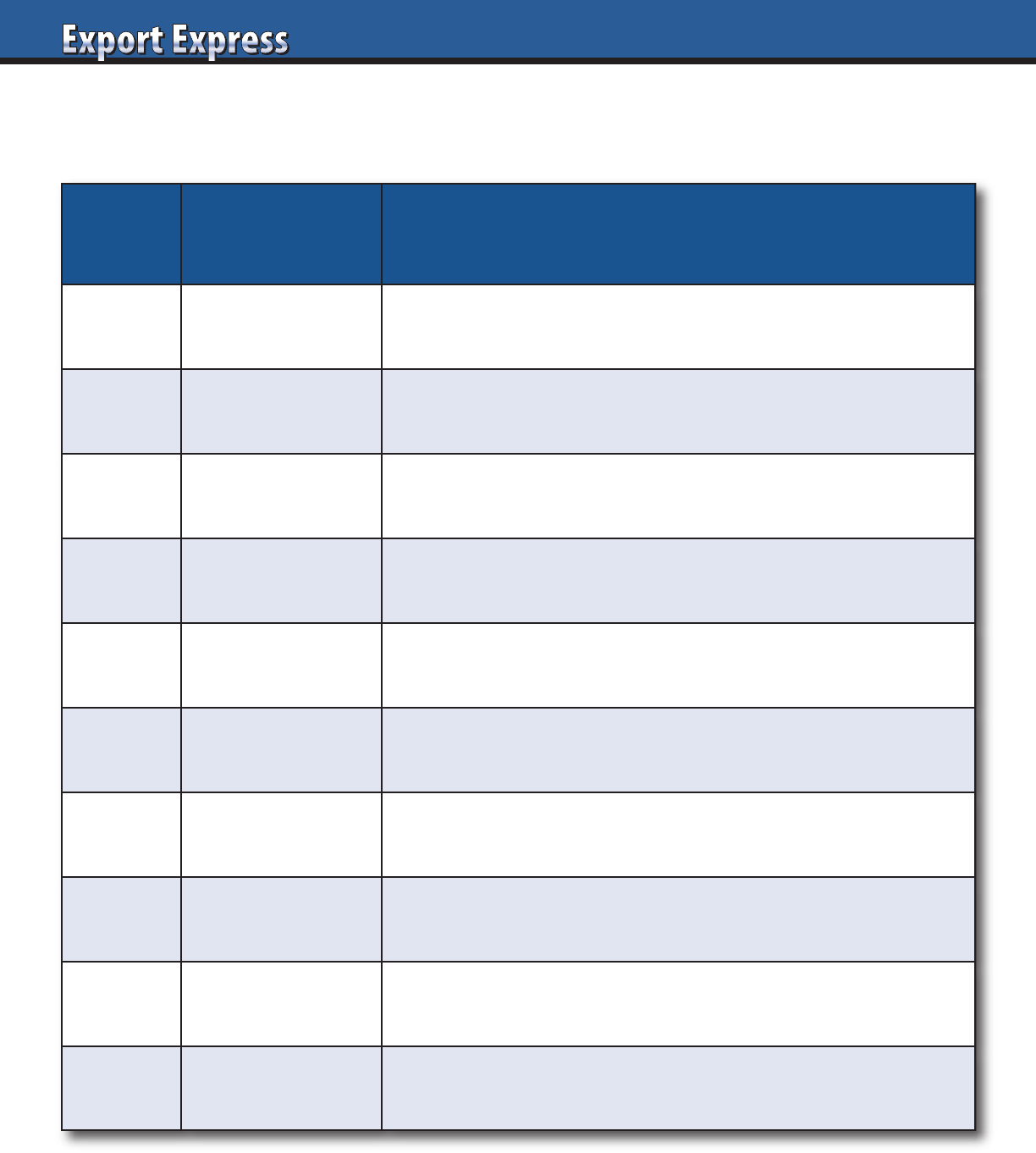
8
Exporter Classication
*
Type Description Export Profile
10 Multinational Strong market share everywhere across multiple categories.
9 Global Multinational. Mix of leading countries and niche participation.
8 Category Champion One core mass category. Strong performance globally.
7 Icon Well known, niche leader. Global availability. Example: Tabasco.
6 Regional Leader Strong share across one continent/region. Some export success.
5 National Hero National treasure, #1 brand. Exports to homesick expats, tourists.
4 Player Respectable share in home country. Opportunistic exports.
3 Participant “Me too” product. Opportunistic exports. “Trader”/private label.
2 Challenger Innovator. Some listings in home country. New to export.
1 Start-up Trying to get traction in home country. Export “dreamer.”
*Export Solutions’ classification system
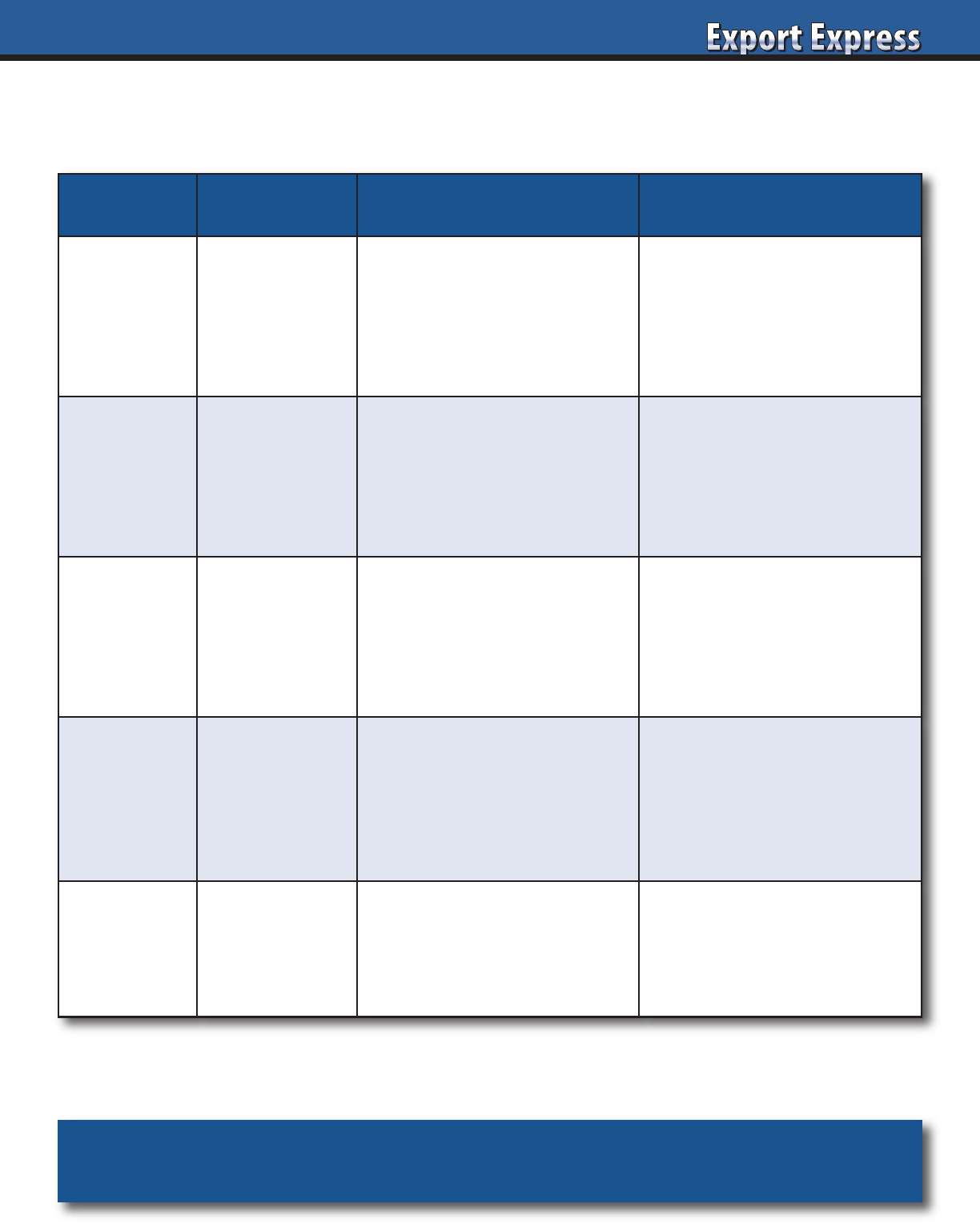
9
Distributor Classication
*
Stars Title Description Prime Prospects
HHHHH
Champion
Massive distributor
Handles multinational/
#1 brands across
many categories
Brand leaders
$$$ marketing budgets
Exporter types: 6-10
HHHH
Captain
Category captain
Handles leading brands
in one segment
Category
innovators/leaders
$$ marketing budgets
Exporter types: 5-9
HHH
Player
Mid-size distributor
Handles #2/3 brands
or niche leaders across
many categories
Differentiated,
premium brands
$-$$ marketing budgets
Exporter types: 4-7
HH
Participant
Respected local
Diversified
product portfolio
Results equal
to investment
Flexible, challenger brands
$ marketing budget
Exporter types: 2-4
H
Pioneer
Small distributor
Entrepreneurial, open to
innovative new companies
Start-up brands
“Pay as you go” marketing
Exporter types: 1-3
Need more information? Visit www.exportsolutions.com.
*Export Solutions’ classification system
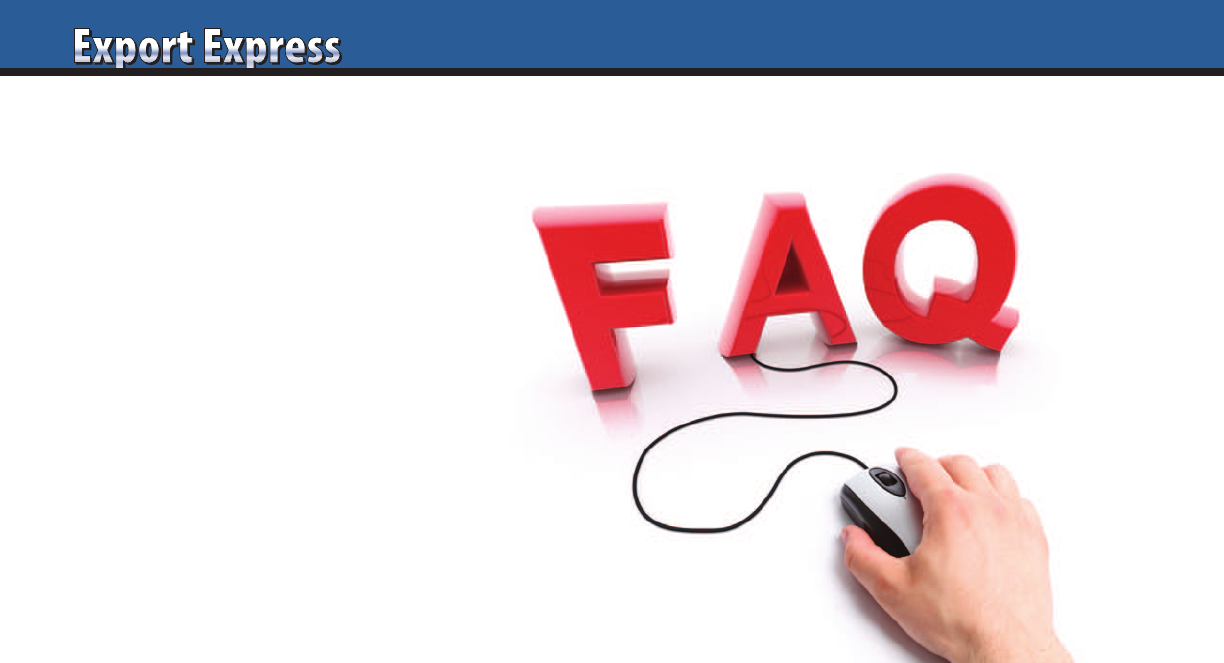
10101010
Why did you create the distributor database?
Export Managers dedicate a lot of time
to networking, always searching for good
distributor recommendations. We waste
precious time at trade shows speaking to
“pretenders” with no hope of adequately
representing our brands. I thought that
the supermarket industry could benefit
from a global distributor database to
instantly find the leading distributors
in any country.
How did you compile the distributor database?
Export Solutions sources distributor
candidates using six specific strategies.
This includes having access to the global
distributor lists of more than 300 brands
and store checks in at least 25 countries
per year.
How accurate is the contact data?
Export Solutions’ distributor database is
updated every day! Distributor company
names, web sites, and specialization
rarely change. This makes the database
98% accurate at the company level. The
distributors’ key contact for new product
inquiries and their email addresses
may change as a result of job moves.
Email address accuracy ranges from
80-90% depending on the country. We
employ three separate mechanisms
to keep up to date with changes.
What’s new?
Our database has expanded to 96 countries
and 9,300 distributors. It’s now searchable,
supplying country and category filter
inputs or brand names! We also offer
90-day access if you purchase a country
or category list. This allows you to work
online and enjoy “one click access” to
distributors’ web sites. Naturally, we
prefer that you purchase an annual
subscription with unlimited access to
the entire database for one year.
What is the difference between
Export Solutions’ distributor database
and other “lists”?
1. Created by industry export professionals,
not directory aggregators or other online
companies with no relevant food/consumer
goods industry experience.
2. Each distributor is personally validated
by Greg Seminara. Distributors can not
self register or pay to be in our database.
We know the difference between a
“best in class” distributor and a “one
man show.”
3. Our distributor database is designed
for manufacturers of branded products
normally sold through supermarkets,
pharmacies, and food service channels.
We do not include distributors of
commodities or ingredients.
4. Call us! Our specialization is
distributor search, with 300+ projects
completed. Contact us for a free copy
of our Distributor Search Guide.
5. Our database is searchable by country,
category specialization, brand name, or
a combination of all three filters.
Which type of companies use our database?
Database clients range from small start-
ups to the largest companies in food
and consumer goods. Export Solutions’
database has had more than 3,000 clients,
including brand owners from all over
the world. Leading government trade
organizations from USA, Italy, Germany,
and Brasil also develop special
agreements to gain access.
What product categories are covered?
Distributors include specialists for branded
food products, confectionery and snacks,
beverage, natural foods, gourmet products,
ethnic food, health and beauty care products,
household products, and general
merchandise. We offer oustanding coverage
of Italian, German, Spanish and UK food
distributors. Many distributors can handle
any product that is normally sold through
supermarkets, convenience, foodservice/
catering, or pharmacy trade channels.
What are best practices in getting the most
productivity from the database?
Successful companies use the database
to screen companies to develop a top five
list of high-potential candidates. They
send a short introductory email with
a web link to their company site. Then,
the export manager follows up with a
phone call within 48 hours. The database
is an excellent tool to invite potential
candidates to an international trade
show like Sial, Anuga, ISM or Sweets
and Snacks. Note: mass mailing
distributors usually generates less
than desirable results.
Does Export Solutions provide any additional
information on the distributors?
Export Solutions knows many of the
distributors in our database. Clients
of our Premium Subscription or Talk
to An Export Expert Services can gain
access to our insights via phone on the
best distributor candidates in any of
the 96 countries we cover.
How do I access the distributor database?
Visit www.exportsolutions.com and
click the distributor database page.
You can place a subscription or country
or category access into a shopping cart.
Register and check out via credit card.
The process takes two minutes and we
automatically send you an invoice.
FAQ’s – Distributor Database
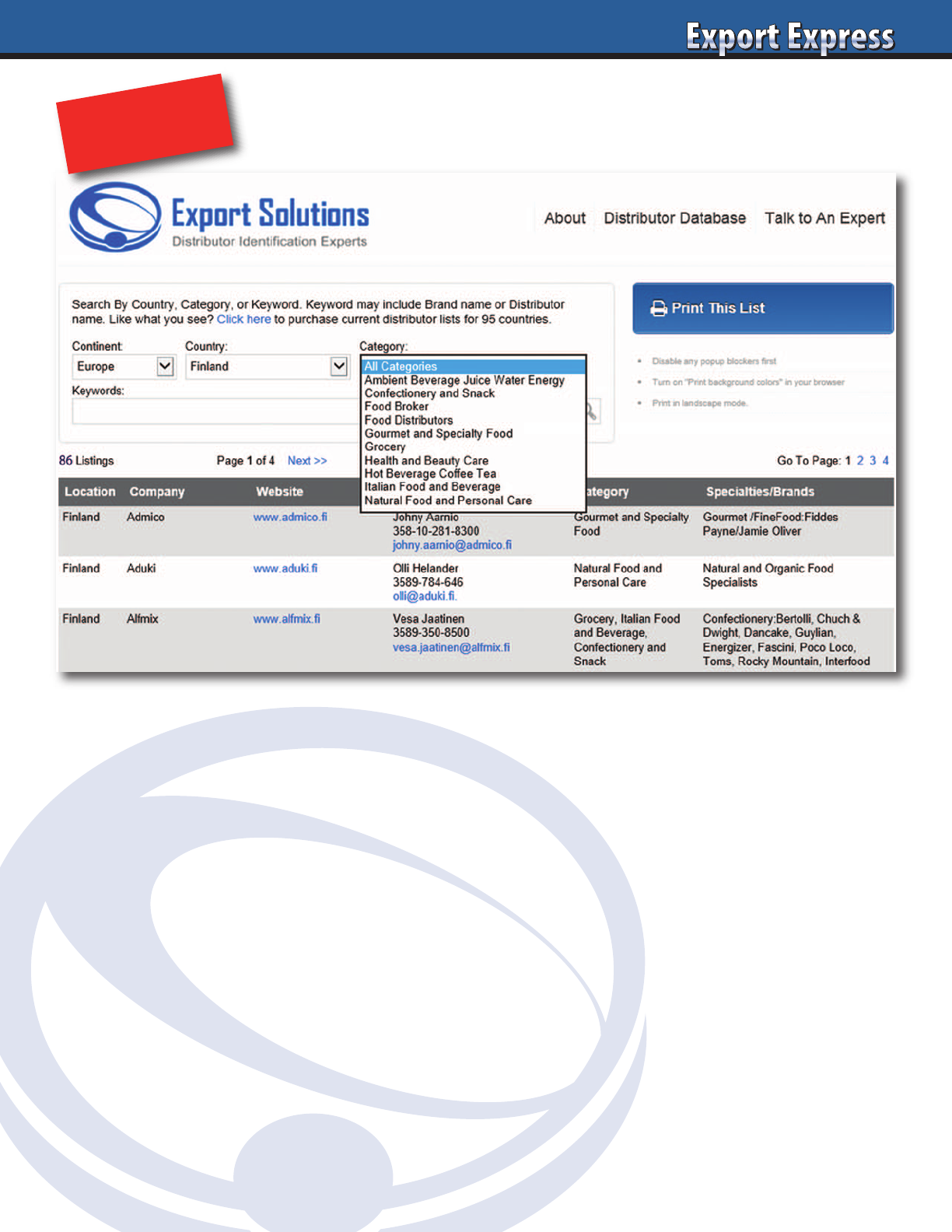
11
Search by Country
Coverage: 96 countries and 9,300 distributors
Search By Category
Confectionery & Snack
Gourmet/Ethnic Foods
Beverage (Ambient & Hot)
Italian Food
Natural Food
Health & Beauty
Search by Brand Name
Tracking distributors for more than 500
of the world’s most famous brands.
Combo Search
Enter multiple factors:
Example 1: Who are confectionary/snack
distributors in Japan?
Example 2: Who is the Barilla distributor
in Mexico?
www.exportsolutions.com
NEW!
Distributor Search Made Simple
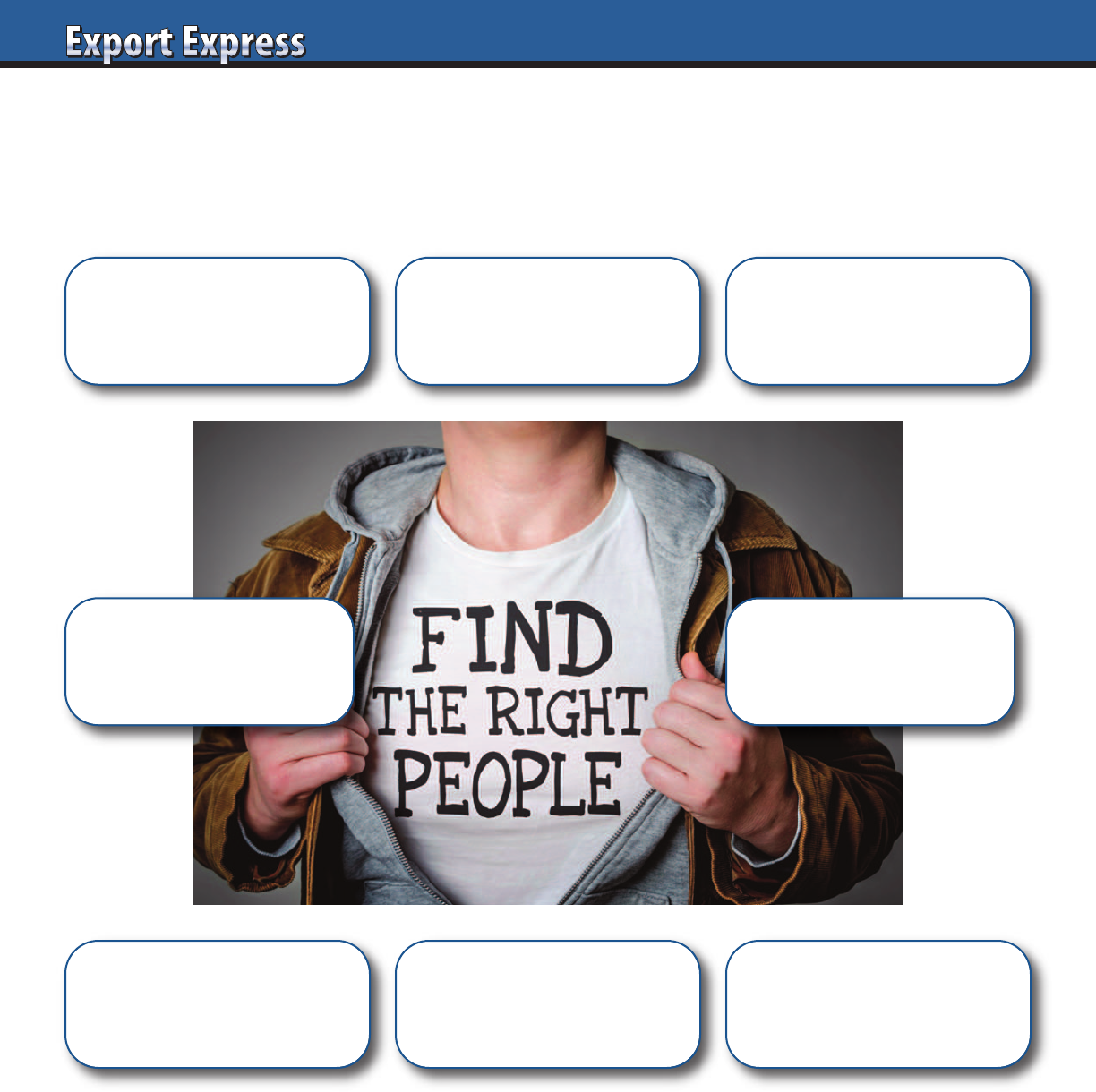
12
We’ve Got You Covered!
Distributor Database Coverage
International Foods
3,345 Distributors
Confectionery & Snack
2,751Distributors
Italian Food
1,417 Distributors
USA Importer/Distributor
614 Distributors
Europe
3,161 Distributors
34 Countries
Asia
2,038 Distributors
17 Countries
Latin America
1,593 Distributors
29 Countries
Middle East
942 Distributors
12 Countries
9,300 distributors – 96 Countries
Subscribe now at www.exportsolutions.com
“Spend time Selling to Distributors versus Searching for Distributors”

